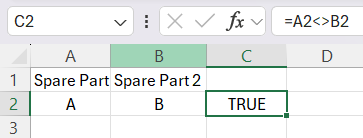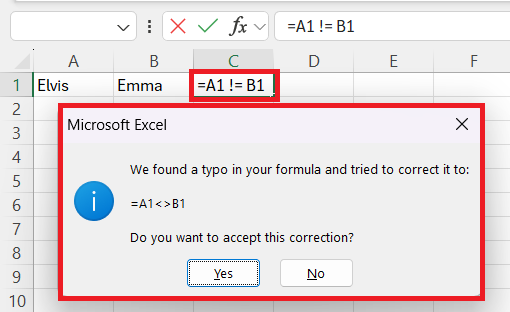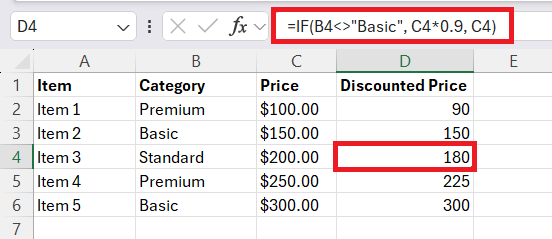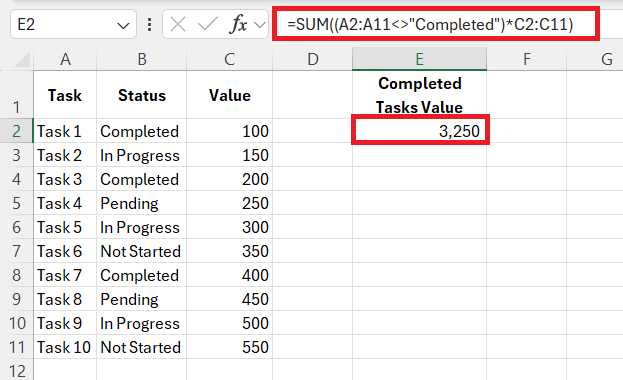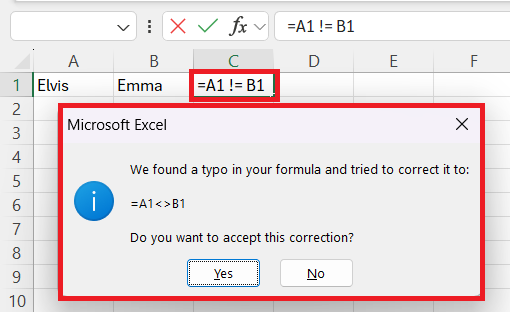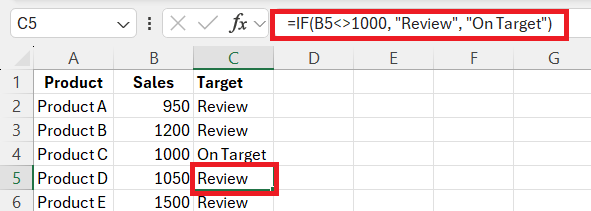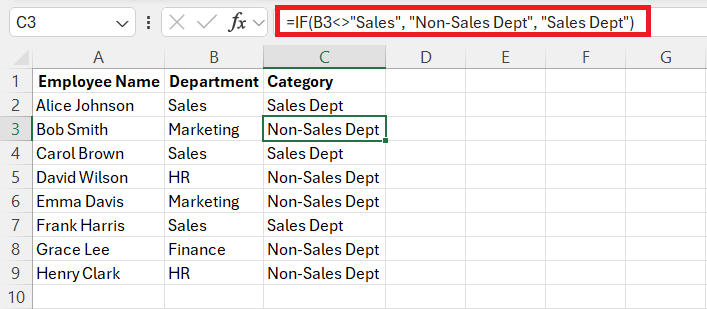In Excel, the “Not Equal To” operator (<>) is used to compare two values and determine if they are different. It’s a key part of logical functions, enabling users to filter data, create conditional statements, and perform calculations based on inequality. Understanding how to use “Not Equal To” efficiently can significantly improve the accuracy and flexibility of your Excel workflows.
Key Takeaways:
- The “Not Equal To” operator (
<>) helps compare values and identify differences in Excel. - It is commonly used in logical functions like
IF,COUNTIF, andSUMIFfor filtering and calculations. - The operator enhances the accuracy of custom calculations and conditional formatting.
- It can be applied within array formulas to handle complex, multi-cell calculations.
- Avoid syntax errors by ensuring no spaces between the
<and>symbols when using<>.
Table of Contents
Welcome to Smarter Excel Sheets
The Role of Logical Operators in Excel Masterpieces
Excel is an incredibly powerful tool for data analysis and manipulation. At the heart of Excel’s functionality is the use of logical operators, which allow you to make decisions and control the flow of calculations based on certain conditions.
These comparison operators, like the “Not Equal To” operator (<>), are essential in crafting smarter Excel sheets. They let us home in on the specifics of data, sieve out discrepancies, and perform targeted calculations with precision.
Understanding the ‘Not Equal To’ Operator
Syntax of ‘Does Not Equal’ in Excel
In Excel, the correct syntax for the ‘Does Not Equal’ operator is represented by <>, a combination of the less than and greater than signs without any intervening spaces. Correct application is critical and involves placing this operator between the two values or cell references being compared.
For example, to test if the value in cell A1 is different from the value in cell B1, the formula would look like =A1<>B1. This will return TRUE if the values are not the same, and FALSE if they are equal.
Remember, Excel formulas are case-insensitive but require precise syntax; an incorrect format such as =A1 ! = B1 will generate an error message.
Excel Formulas Simplified with ‘Not Equal To’
Custom Calculations and Conditional Formatting Tricks
Custom calculations and conditional formatting are two areas where the ‘Not Equal To’ operator truly shines. Let’s delve into how to leverage it for more insightful and visually appealing spreadsheets:
For custom calculations, imagine setting up a discount system where only items of a specific category are excluded. The formula might look something like =IF(A4<>"Basic", C4*0.9, C4), offering a 10% discount on all items except those labeled ‘Basic’.
Through the creative use of the ‘Not Equal To’ operator, you can craft not only functional but also visually intuitive Excel sheets, making data easier to interpret and actions clearer to prioritize.
Leveraging ‘Not Equal To’ in Complex Array Formulas
Leveraging the ‘Not Equal To’ operator within array formulas unlocks the potential for handling complex, multi-cell calculations with ease. Array formulas can process several values simultaneously and work exceptionally well for bulk operations, where you may want to apply conditions across a range of data.
For instance, the formula =SUM((A2:A11<>"Completed")*C2:B11) brilliantly demonstrates this. It sums all the values in the range C2:C11 where the corresponding cells in A2:A11 are not marked as completed. It’s essentially filtering and calculating in one fell swoop.
Array formulas with ‘Not Equal To’ could be used for complex tasks such as:
- Counting the number of cells that do not match a certain criterion across a large dataset.
- Summarizing values that are uniquely distinct from a defined parameter.
- Performing bulk replacements or updates where only certain conditions are met, not affecting the entire dataset.
By understanding and applying these advanced formula techniques, spreadsheet capabilities are greatly enhanced, resulting in a higher level of refinement in data analysis and reporting.
Common Pitfalls and How to Avoid Them
Navigating Incorrect Syntax and Common Errors
Navigating the challenges of incorrect syntax and common errors with the ‘Not Equal To’ operator starts with recognizing the importance of precise formula structure in Excel. One misplaced character or space can cause the whole formula to malfunction, leading to incorrect results or error messages.
To avoid syntax-related blunders, it’s essential to remember that there should be no spaces between the less than (<) and greater than (>) signs when crafting a ‘Not Equal To’ (<>) condition. Missteps often occur when users unintentionally add spaces or use an exclamation mark (!) instead of the proper operator, such as =A1 ! = B1, which Excel does not recognize.
A pro tip to ward off these errors is to double-check formulas before pressing Enter and to make sure that Excel’s formula suggestions aren’t ignored—these are designed to detect and reduce syntax errors.
Additionally, using Excel’s built-in ‘Formula Auditing’ tools can help identify and correct many common errors quickly. Through diligent attention to detail and using available resources, we can master Excel’s precise syntax requirements and ensure our ‘Not Equal To’ conditions operate flawlessly.
Practical Examples to Illustrate Usage
Sales Data, Financial Analysis, and HR Management
The ‘Not Equal To’ operator plays a vital role in the specialized tasks of sales data analysis, financial scrutiny, and human resource management within Excel.
In sales data analysis, for example, this operator can identify products whose sales are either below or above a certain threshold, such as =IF(B2<>1000, "Review", "On Target"). This conditional logic isolates particular cases, like flagging products that either underperform or surpass sales forecasts, enabling focused strategy development.
In the realm of human resources, the operator helps manage diverse datasets effectively. It can sift through employee records to filter out specific attributes — imagine filtering all employees except those in a particular department (=IF(A2<>"Sales", "Non-Sales Dept", "Sales Dept")).
In essence, ‘Not Equal To’ is indispensable for crafting highly functional Excel sheets that tackle the unique challenges within these distinct fields, guiding data analysts, finance professionals, and HR managers toward more informed decisions.
FAQs on Mastering the ‘Not Equal To’ Operator
What does <> mean in Excel?
In Excel, <> is the ‘Not Equal To’ logical operator used to compare two values. If the values on either side of <> do not match, the result is TRUE; if they match, the result is FALSE. It’s essential for filtering data and condition-based calculations.
How to apply not equal to in Excel formulas?
To apply the ‘Not Equal To’ operator in Excel formulas, you use <> between the values or cells you’re comparing. Enter =, click the first cell, type <>, and then the value or second cell. For example, =A1<>B1 checks if A1 is different from B1.
What is “not equal to” used for in Excel?
The ‘Not Equal To’ operator in Excel is used for identifying and working with values that do not match specific criteria, like filtering distinct items, validating data, and executing conditional functions like IF for targeted calculations based on non-equal conditions.
Can ‘Not Equal To’ Be Combined with Other Logical Functions?
Yes, the ‘Not Equal To’ operator can indeed be combined with other logical functions like IF, AND, and OR in Excel to create complex conditional statements and perform sophisticated data analysis that responds to multiple criteria simultaneously.
How to Handle Data Discrepancies using ‘Not Equal To’?
To handle data discrepancies using ‘Not Equal To’, you can craft formulas that compare datasets and reveal mismatches. Use =IF(A1<>B1, "Discrepancy", "Match") to flag differences, informing you of potential errors or outlier data that may need further investigation or correction.
John Michaloudis is a former accountant and finance analyst at General Electric, a Microsoft MVP since 2020, an Amazon #1 bestselling author of 4 Microsoft Excel books and teacher of Microsoft Excel & Office over at his flagship MyExcelOnline Academy Online Course.

